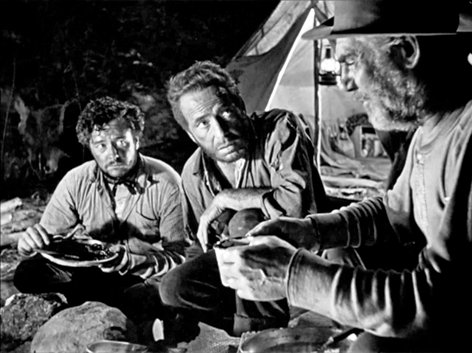 John Huston’s 1948 classic took some very unusual risks for a Hollywood movie of that era, and it won popular and critical acclaim.
John Huston’s 1948 classic took some very unusual risks for a Hollywood movie of that era, and it won popular and critical acclaim.
I often try to shine a light on older movies that are obscure or that you might not have heard of, but today I want to talk about a film you probably have heard of, and maybe even seen. The Treasure of the Sierra Madre, a John Huston film released in 1948, is an example of how bold and original work could sometimes emerge from a Hollywood system that was generally wary of taking chances.
I really love this movie. It was based on a novel by a mysterious writer named B. Traven. Huston stuck pretty close to the book in his screenplay. And the whole thing was shot on location in northern Mexico—at that time this was still pretty unusual for a Hollywood film. The story concerns three prospectors, drifters, looking for gold in the mountains, and how things go wrong once they find it. One of them, played by Humphrey Bogart, becomes corrupted by the gold, with bad consequences for all three of them.
Huston achieved a very stark, elemental feeling here. There’s no fat on this movie—everything serves to either drive the story or set the mood. If you really study the famous scene between Bogart and the bandits, for instance—a sequence which might almost seem too familiar—you will be impressed by the way the tension is slowly and carefully built to the point of sudden, inexplicable violence. I love the way Bogart’s character, Fred C. Dobbs, gradually regresses from a hardy loner type, not a bad fellow, to a vindictive paranoid lunatic. It is a very brave, honest performance. Bogie was willing to try something different here. By this time he was a star and he was playing tough good guys. Dobbs is an unsavory, pathetic, self-pitying character, a very risky role for a big star, and Bogie gives him life and even a little sympathy.
Walter Huston, the director’s father, was one of the great American actors of the twentieth century. The grizzled old man Howard, the natural leader of the three gold hunters, who has gained a certain worldly wisdom with his years, was a great role for him—it nabbed him his only Oscar. Tim Holt, who had a rather undistinguished career outside of this film and Orson Welles’ The Magnificent Ambersons, is solid as the young man Bob, a sort of counterweight to Bogie’s character.
There’s a moral seriousness to the film, a kind of grim dramatic logic that is remarkable for a major studio production. It’s not surprising that Jack Warner, the head of the Warner Brothers studio, didn’t like it, since it didn’t fit into any formula. Contrary to expectations, however, the picture succeeded not only critically but with audiences. I think it’s because John Huston keeps things raw and simple. We’re allowed to make up our own minds.
The ending strikes a note of universal truth that anyone can relate to. It’s not a bitter ending, but a very life-affirming one, although it might not seem so at first. The quest, its futility, and the way men are defeated by it or find a deeper inner resource because of it—these are the themes that help keep The Treasure of the Sierra Madre in the pantheon of American classics.

John Carpenter’s first feature, a low budget science fiction comedy, drily exposes the complete inadequacy of human beings when measured against the cosmos. John...

This film features real people playing themselves in a drama about a young rodeo hotshot whose career has been cut short by a head...

A mystery from Argentina becomes a meditation on love, art, and the agency of women. Trenque Lauquen, a film by Argentine director Laura Citarella,...